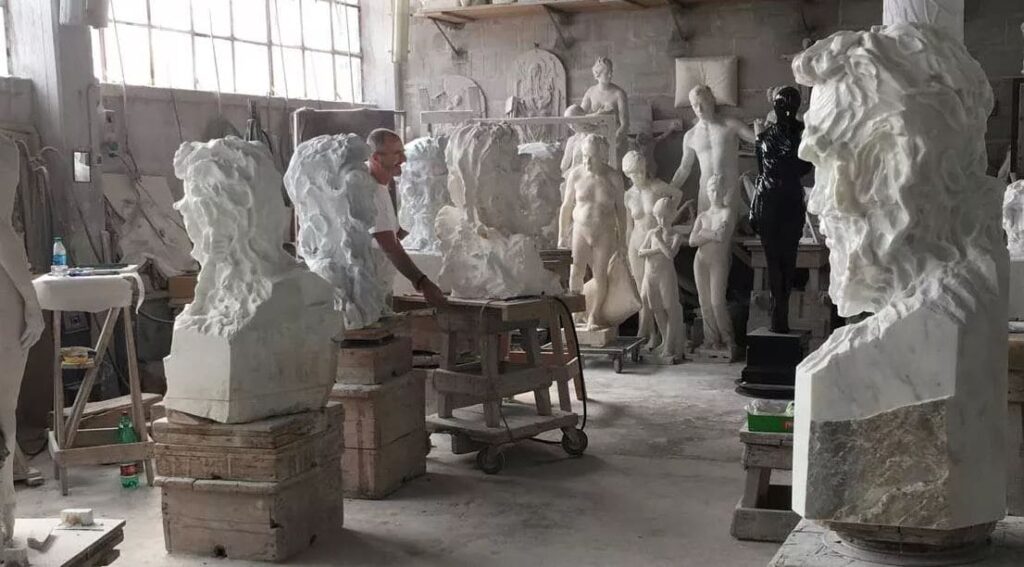Introduction
Creating a sculpture from marble is a demanding and elaborate undertaking that necessitates a combination of creativity and skilled craftsmanship. In this case, the sculpture is created through a unique blend of art and technology. Sculpture-making is a step-by-step process that involves sketching a masterpiece, modeling a prototype, and crafting a marble into real-world objects, including inanimate and living things.
Sketching a Masterpiece
The first step of making a marble sculpture involves turning the original abstract idea into a drawing. For instance, marble carving starts with a preliminary plan involving a formulation of a masterpiece and sketching it with actual measurements, identification and choice of a stone, adjustments, and appropriate preparation of the block to reproduce the original idea precisely.1 Sketching is essential as it allows the sculptor to visualize the actual object and its dimensions to achieve the intended size, including the sculpture’s final aesthetic and its messaging. Therefore, the sculptor must be cautious and keen with the initial step to verify that it satisfies the required criteria. Sculptors keen on storytelling may draw parallels to how to write an essay about a quote, as this approach emphasizes clarity in communicating complex ideas.
1. Mahmoud M. Farag, Materials and Processes of Contemporary Sculpture (United Kingdom: Cambridge Scholars Publishing, 2020), 143.

Modeling a Prototype
The second step involves converting the sketch of the abstract idea into a clay or wax model of the intended sculpture, a critical phase in the development of the actual work. Classical sculptors used flexible materials, such as clay, to create a prototype of the sculpture to execute their artistic thoughts and conceptions effectively, but, today, other substances, like synthetic polymer and resin, are used because of their elasticity.2 The modeling illustrates the culmination of the sculpture’s design, a significant step in the creation process because it allows artists to modify the conception before the final sculpting begins. Hence, artists must focus on every aspect to ensure the prototype replicates the final sculpture.
2. Chao Gao et al. “Research on the Analysis and Application of Polymer Materials in Contemporary Sculpture Art Creation,” Polymers 15, no. 12 (2023): 2, https://doi.org/10.3390/polym15122727.
Crafting a Marble
The final step is crafting a marble, which involves a series of activities to turn the model into an authentic sculpture capable of communicating a logical message to society. For example, the primary phases of crafting a marble include carving, smoothing, and engraving, which occur sequentially.3 Firstly, the sculptor commences with a flat block of marble and utilizes an emery abrasive tool to chop off the top layer of stone until the primary shape of the sculpture is visible. Then, the artist rubs the sculpture’s surface with a flint rock, intending to give it a finer, curvier shape and generate intricate details. Lastly, a strong and pointed tool is utilized to inscribe the marble to include additional characteristics and form the geometrical contours of specific portions of the sculpture.
3. Panayiotis Koutsabasis and Spyros Vosinakis, “Kinesthetic Interactions in Museums: Conveying Cultural Heritage by Using Ancient Tools and (Re-) Constructing Artworks,” Virtual Reality 22, no. 2 (2018): 5, https://doi.org/10.1007/s10055-017-0325-0.
Conclusion
Creating the marble sculpture requires great care while handling and working on the final object. Producing it involves three detailed steps, including sketching a masterpiece, modeling a prototype, and crafting a marble to achieve the abstract idea. The main focus should be developing an objective and paying attention to initial activities, developing a prototype model with no faults, and being keen throughout while interacting with the marble in the final stage for a successful sculpture.
Bibliography
Farag, Mahmoud M. Materials and Processes of Contemporary Sculpture. United Kingdom: Cambridge Scholars Publishing, 2020.
Gao, Chao, Feng Wang, Xiaobing Hu, and Ming Zhang. “Research on the Analysis and Application of Polymer Materials in Contemporary Sculpture Art Creation.” Polymers 15, no. 12 (2023): 1-19. https://doi.org/10.3390/polym15122727.
Koutsabasis, Panayiotis, and Spyros Vosinakis. “Kinesthetic Interactions in Museums: Conveying Cultural Heritage by Using Ancient Tools and (Re-) Constructing Artworks.” Virtual Reality 22, no. 2 (2018): 1-17. https://doi.org/10.1007/s10055-017-0325-0.


